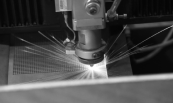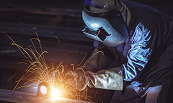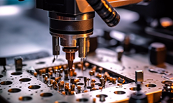0.11 How Laser Cutting is Used in Aerospace & Medical Devices
The fields of aerospace and medical device manufacturing demand absolute precision, traceability, and reliability. Components must meet stringent tolerances, endure high stress, and comply with strict industry standards. Traditional machining methods often fall short in achieving such high-performance benchmarks. This is where laser cutting stands out — offering non-contact, high-precision, clean, and efficient cutting for even the most complex parts.
In this detailed guide, we explore how laser cutting technology is revolutionizing manufacturing in the aerospace and medical industries. From cutting titanium alloys for jet engines to producing microscopic stents and surgical tools, lasers are not just tools — they’re enablers of innovation.
Why Laser Cutting is Ideal for Aerospace & Medical Industries
These industries share critical manufacturing priorities:
- High precision (±0.01 mm or better)
- Clean edges with no thermal damage
- Compatibility with delicate and high-value materials
- Minimal contamination risk
- Flexibility for intricate or custom shapes
Laser cutting meets these demands through:
- Non-contact cutting (no tool wear)
- Narrow kerf width and excellent edge quality
- Minimal Heat-Affected Zone (HAZ)
- Superior repeatability and automation integration
Machines like the GH Series from Laser Technologies deliver micron-level accuracy, making them suitable for both large aerospace parts and delicate medical-grade components.
Laser Cutting in Aerospace Manufacturing
The Aerospace Challenge
- Complex geometries and materials
- Demand for lightweight, high-strength components
- Need for traceability and consistency
- Multi-material integration (titanium, aluminum, composites)
Common Aerospace Materials Processed by Lasers:
- Titanium (used in airframes, engine parts)
- Nickel alloys (e.g., Inconel)
- Aluminum alloys
- Carbon fiber composites
- Stainless steels (for exhausts, fasteners)
Aerospace Parts Typically Laser Cut:
- Brackets and structural supports
- Jet engine turbine shrouds
- Aircraft skin panels
- Honeycomb structures
- Heat shields
Benefits of Laser Cutting in Aerospace:
- Low-distortion cutting of thin or delicate sheets
- Reduced finishing time(minimal burring)
- High repeatability for mass production
- Support for CAD-driven manufacturing
- Flexible cutting for custom and low-volume parts
Aerospace companies use high-power fiber lasers (4kW to 12kW) from Laser Technologies for precise cutting of aircraft components with low HAZ and tight tolerance.
Laser Cutting in Medical Device Manufacturing
The Medical Manufacturing Need
- Micron-level precision
- Biocompatibility
- Sterility and contamination control
- Miniaturized, delicate components
Commonly Laser-Cut Medical Materials:/span>
- Stainless steel (316L, 304)
- Titanium and nitinol (shape memory alloys)
- Polymers and ceramics
- Cobalt-chromium alloys
Medical Components Created Using Laser Cutting:
- Orthopedic implants (plates, rods, bone screws)
- Stents and vascular implants
- Endoscopic instruments
- Surgical scissors and forceps
- Hearing aid and dental components
Benefits of Laser Cutting in Medical Manufacturing:
- Contactless operation reduces contamination
- Sharp, micro-fine cuts for delicate tools
- Excellent reproducibility for mass production
- Highly customizable — suitable for personalized medicine
With fiber laser micro-cutting systems, manufacturers can cut stent patterns with strut widths as low as 50 microns. Laser Technologies offers solutions that meet such precision standards.
Types of Lasers Used in Aerospace & Medical Sectors
Fiber Lasers
- Most widely used in aerospace and medical cutting
- High beam quality and energy efficiency
- Power range: 500W to 12kW+
UV Lasers (for polymers & sensitive materials)
- Used for clean room-grade operations
- Ideal for marking and precision cutting without thermal impact
Femtosecond & Picosecond Lasers
- Ultrafast lasers that produce virtually no heat
- Used in advanced medical cutting, micromachining, and implant production
For general industrial and aerospace applications, GH Series Fiber Lasers from Laser Technologies offer the best mix of power, speed, and reliability.
Key Machine Features for These Industries
When selecting a laser machine for aerospace or medical manufacturing, consider:
Beam Quality
- Higher beam quality = finer cuts and less HAZ
CNC Integration
- For precise motion control and repeatability
Software Compatibility
- Must support medical-grade traceability (UIDs, part IDs)
Micro-Machining Capability
- Required for stents, fine instruments, and flexible implants
Automation-Ready Interface
- Robotic loading/unloading, MES system compatibility
Laser Technologies provides machines with CNC-driven positioning, auto-focus heads, and IoT monitoring features to meet these needs.
Industry Certifications and Regulatory Compliance
Aerospace Requirements:
- AS9100 (Quality Management)
- NADCAP (for aerospace special processes)
- ISO 9001 (General quality systems)
Medical Requirements:
- ISO 13485 (Medical device manufacturing)
- FDA compliance (for export)
- Clean room certifications (for Class I–III devices)
Laser cutting machines used in these sectors must:
- Offer repeatable output
- Be integrated with traceability systems
- Enable documented validation and calibration
Laser Technologies machines are compliant with ISO standards and suitable for integration into certified environments.
Sample Case Studies
Aerospace Application: Turbine Blade Shield Cutting
- Material: Nickel alloy
- Machine: 6kW GH Series Fiber Laser
- Result: Achieved consistent edge quality with less than 0.05mm tolerance, reducing post-machining by 40%
Medical Application: Laser-Cut Stents
- Material: Nitinol (memory metal)
- Process: Laser micro-cutting with inert gas shielding
- Result:Strut width of 60µm, burr-free, no recast layer
Contract Manufacturing Unit
- Supplies both aerospace brackets and orthopedic implants
- Uses two machines: one GH Series 3kW, and one UV-based micro-laser
- Reduced overall part production cost by 20% through laser process optimization
Common Challenges and How Laser Solves Them
| Challenge | Traditional Method | Laser Cutting Advantage |
|---|---|---|
| Complex geometries | Difficult or impossible | CAD-driven, flexible tool path |
| Thin-walled material distortion | Common in mechanical cutting | Minimal HAZ and precision beam |
| Risk of contamination | High (contact tools, fluids) | Contactless, clean operation |
| Tool wear and replacement | Regular maintenance required | No physical wear in laser beam |
| Low-volume production | Expensive with molds/dies | Rapid prototyping friendly |
Future of Laser Cutting in These Sectors
Aerospace Innovations:
- Additive + subtractive hybrid systems
- Real-time AI control during cutting
- On-site 3D laser cutting robots for repair
Medical Device Trends:
- Fully automated micro-fabrication of implants
- Nano-scale structuring of surfaces for bio-integration
- Personalized surgical devices made on demand
Technology Integrations:
- MES + ERP + CNC integration
- Live quality monitoring and closed-loop control
- Augmented reality-based laser programming
Laser Technologies is at the forefront of innovation, preparing their GH Series systems for AI, robotics, and cloud-based integration.
Laser cutting is no longer just an industrial tool — it’s a critical enabler of innovation in aerospace and medical device manufacturing. It meets the exacting standards these industries require and supports the flexibility modern production demands.
From jet engine heat shields to delicate vascular implants, laser systems like those from Laser Technologies India deliver the reliability, precision, and compliance needed to keep businesses competitive.
Explore the full range of high-precision laser solutions at LaserTechnologies.co.in






